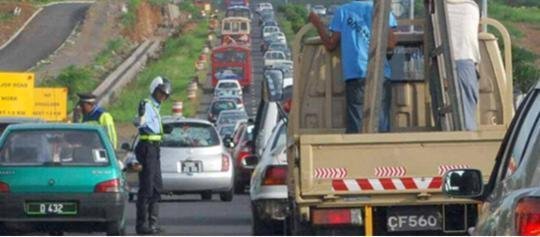The bill for jams in 2011: Rs3bn

That's what it will cost this year and it can only get worse...
Traffic jams are a fact of life in Mauritius. The bad news is that they will get worse before they get better.
According to Mr Caderassen Dorsamy, General Manager of the Road Development Authority, traffic congestion will cost the country from Rs2.5 billion to Rs3 billion this year because of lost productivity and damage to the environment and human health. And that bill can only increase as more and more vehicles take to our already clogged roads.
The latest report from the Central Statistics office (CSO) on road transport and road traffic reveals that the number of vehicles registered at the National Transport Authority (NTA) was 384,115 at the end of 2010.
This represents a net increase of 17,595 or 4.8% compared to the end of 2009.
At the end of last year, the fleet consisted of 175,634 (45.7%) cars and dual purpose vehicles and 159,329 (41.5%) motorised two-wheelers.
The remaining 12.8% comprised 25,914 vans, 13,186 lorries and trucks, 2,845 buses and 7,207 other vehicles.
In a major report four years ago, the Mauritius Employers’ Federation (MEF) said that 97.1% of the enterprises surveyed are adversely affected by traffic congestion, “with nearly 40% reporting a very high adverse impact”.
The federation also said that 76.8% of the enterprises were hit by higher vehicle operating costs and fuel expenses due to traffic congestion. In 63.8% of cases, business operations are negatively affected by lateness and absenteeism caused by traffic jams.
The business hit-list includes delayed deliveries, increased transport and distribution costs, loss of productivity and competitiveness, increased labour and overtime costs, decreased quality of service, lower sales and higher inventory levels and costs.
Business activities are also influenced by stress due to time lost by employees snagged in traffic, uncertainty created by disruption to the daily schedule and difficulty to serve customers in certain regions of the country.
“Furthermore,” warned the report, “according to 62.3% of enterprises, traffic congestion is a very important deterrent to future investment plans.” According to the employers surveyed for the report, successive government actions to alleviate traffic congestion were insufficient and dissatisfactory.
“Expanding the road network and decentralising some of the key government and business services out of Port Louis are considered as the most effective solutions to the problem,” the report added.
But is there light at the end of the traffic tunnel? Mr Anil Bachoo, Minister of Public Infrastructure, National Development Unit, Land Transport and Shipping, said in parliament that plenty of work falling under the Road Decongestion Programme has been completed, with more than Rs4 billion spent in the past five years.
“Traffic congestion is our biggest challenge, and this has increased as a result of national economic growth. Our standard of living also has increased significantly and, in parallel, car ownership has also risen in proportion,” he said.
At the end of 2001, 255,149 vehicles were registered at the NTA. Over the past decade (2001-2010) the number of vehicles registered was 128,966, an increase of more than 50%, according to CSO.
Mr Bachoo said that in the past traffic congestion was limited to Port Louis, particularly in its main arteries and roads. But that is no longer the cases; the traffic jam disease is spreading. “From North to South, and from East to West, it has spread throughout the nook and corner of the country,” said Mr Bachoo.
“The problem is that despite a rapid increase in the number of vehicles on the roads of Mauritius, the road network had not known too much of improvement. It’s for this reason that we have started the Road Decongestion Programme, and every year we have to spend Rs25 billion. This is a project on infrastructure in general, with the lion’s share going to the construction of roads.”
Minister Bachoo maintains the government is investing massively on improving accessibility and mobility. “However, in our congestion management strategy, we are improving our public transportation system also,” he added.
His ministry is working on the modalities for the implementation of a rapid transit system with the technical assistance of experts from Singapore.
“We are moving ahead with the project,” said Mr Bachoo. But that particular project is still years away. In the meantime, the traffic logjam continues to frustrate politicians and the public alike.
Decongestion... at a cost
The Road Development Authority’s Caderassen Dorsamy listed the major ongoing and forthcoming projects, costing a total of Rs25 billion, that government hopes will bring some relief to exasperated drivers:
- The Terre-Rouge-Verdun-Trianon link road will be completed by the end of 2012.
- Upgrading of the existing highway from Phoenix to Port- Louis from two to three lanes to be completed at the end of next year.
- The Phoenix-Beaux-Songes link road to be completed by August this year.
- Port Louis Ring Road to enter the capital, starting from Montebello via Swami Vivekananda International Convention Centre, Guibies, cross Signal Mountain through a tunnel and continue to Champ de Mars via Tranque-Bar and Chateau D’eau. Another phase of this project will link Belle Etoile to Montebello. The whole project will be completed between 2014 and 2015.
- The Harbour Bridge will start from the M1 motorway near the Royal College of Port Louis, cross the harbour for over 460 metres, before joining the M2 motorway near Lataniers Bridge at Roche Bois, at the northern entrance of the capital. Not yet started but it is estimated to be completed in 2015.
- Upgrading and construction of new highways routing towards the North are under construction, with dual carriageway to Grand Bay.
- The Caudan flyover to be completed during this year.
- Two bypasses, in Triolet and Goodlands respectively, already open.
Nouvelles connexes


